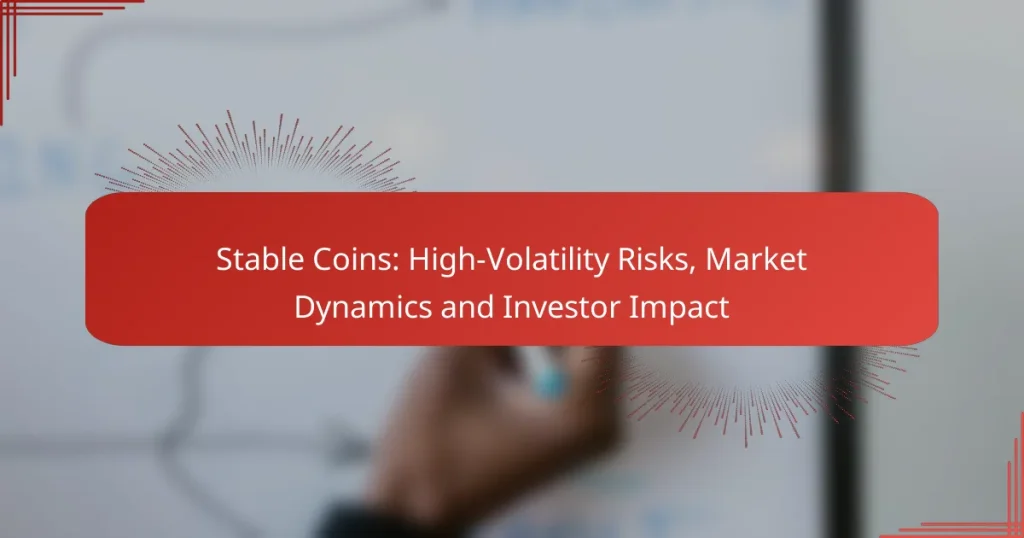Cryptocurrency stable coins are designed to maintain a stable value, but they come with inherent risks that can affect their reliability and usability. Key risks include market volatility, regulatory challenges, and technological vulnerabilities, which can undermine the stability of these digital assets. Understanding these risks is crucial for investors looking to navigate the complex landscape of stable coins effectively.
Stable Coins: Counterparty Default Risks and Transaction Security
Stable Coins: Regulatory Risks and Compliance Challenges
Stable Coins: High-Volatility Risks, Market Dynamics and Investor Impact
Stable Coins: Market Manipulation Effects and Stability Concerns
Stable Coins: Geographic Risks, Market Variability and Regulatory Factors
Stable Coins: Algorithmic Risks, Investor Considerations and Market Behavior
What are the risks of cryptocurrency stable coins?
Cryptocurrency stable coins carry several risks that can impact their value and usability. These risks include market volatility, regulatory uncertainty, liquidity issues, counterparty risk, and technological vulnerabilities, each of which can affect the stability and reliability of these digital assets.
Market volatility
Despite being designed to maintain a stable value, stable coins can still be affected by market volatility. If the underlying asset or collateral backing the stable coin experiences significant price fluctuations, it can lead to instability in the stable coin’s value. For instance, if a stable coin is pegged to a volatile cryptocurrency, its value may not remain constant as intended.
Investors should monitor the performance of the assets backing stable coins and be aware that extreme market conditions can lead to temporary de-[censured], where the stable coin trades below or above its intended value.
Regulatory uncertainty
Regulatory uncertainty poses a significant risk to cryptocurrency stable coins, as governments around the world are still determining how to classify and regulate these assets. Changes in regulations can impact the operations of stable coin issuers, potentially leading to restrictions or bans that affect their availability and usage.
Investors should stay informed about regulatory developments in their jurisdiction, as these changes can create sudden shifts in the market and influence the stability of stable coins.
Liquidity issues
Liquidity issues can arise when there is not enough market activity to support the buying and selling of stable coins. If a stable coin lacks sufficient trading volume, it may be difficult for holders to convert it back to fiat currency or other cryptocurrencies without incurring significant slippage or delays.
To mitigate liquidity risks, investors should choose stable coins that are widely traded on reputable exchanges and have a strong market presence.
Counterparty risk
Counterparty risk refers to the possibility that the issuer of a stable coin may fail to honor its obligations, such as redeeming the stable coin for its pegged value. This risk is particularly relevant for fiat-backed stable coins, which rely on the issuer’s ability to maintain reserves and transparency.
Investors should evaluate the credibility and financial stability of the stable coin issuer, looking for those that provide regular audits and clear information about their reserve holdings.
Technological vulnerabilities
Technological vulnerabilities can expose stable coins to risks such as hacking, software bugs, or network failures. These issues can lead to loss of funds or disruptions in the stable coin’s operations, affecting its reliability as a stable asset.
To reduce exposure to technological risks, investors should use stable coins that are built on secure and well-established blockchain platforms, and remain vigilant about updates and security practices from the issuers.
How to mitigate stable coin risks?
To mitigate stable coin risks, investors should adopt a multi-faceted approach that includes diversification, using reputable platforms, and ensuring regular audits. These strategies help reduce exposure to potential losses and enhance overall security in the volatile cryptocurrency market.
Diversification strategies
Diversification is essential in managing risks associated with stable coins. By spreading investments across multiple stable coins and other asset classes, investors can minimize the impact of any single asset’s poor performance. Consider allocating funds to various stable coins that are pegged to different currencies or backed by different assets.
For example, an investor might hold a mix of USDT, USDC, and DAI to balance exposure. This strategy can help cushion against market fluctuations and the potential failure of any one stable coin.
Using reputable platforms
Selecting reputable platforms for trading and holding stable coins is crucial for risk mitigation. Look for exchanges and wallets with strong security measures, transparent operations, and a good track record. Platforms that comply with local regulations and have insurance policies in place can provide additional peace of mind.
Research user reviews and industry ratings to identify trustworthy platforms. Avoid lesser-known exchanges that may not have robust security protocols, as they can expose your assets to higher risks.
Regular audits
Regular audits of stable coin reserves and operations are vital for ensuring transparency and trustworthiness. Investors should look for stable coins that undergo independent audits to verify their backing assets and compliance with regulatory standards. This can help confirm that the stable coin is genuinely backed by the assets it claims to hold.
Stay informed about the audit reports and findings, as these can provide insights into the stability and reliability of the stable coin. Choose stable coins that are committed to regular audits to enhance confidence in their long-term viability.
What are the types of stable coins?
Stable coins are categorized primarily into three types based on their backing mechanisms: fiat-collateralized, crypto-collateralized, and algorithmic stable coins. Each type has distinct characteristics, risks, and benefits that influence their stability and usability in the cryptocurrency market.
Fiat-collateralized stable coins
Fiat-collateralized stable coins are backed by traditional currencies like the US dollar or euro, with reserves held in a bank or financial institution. For example, a stable coin like Tether (USDT) aims to maintain a 1:1 peg with the US dollar, meaning for every USDT issued, there is an equivalent dollar held in reserve.
Investors should consider the transparency of the issuing company and the regularity of audits to ensure that sufficient reserves are maintained. Risks include regulatory scrutiny and potential insolvency of the issuing entity, which can affect the coin’s value.
Crypto-collateralized stable coins
Crypto-collateralized stable coins are backed by other cryptocurrencies instead of fiat currencies. These coins, such as DAI, use smart contracts to lock up a certain amount of cryptocurrency as collateral, which is often over-collateralized to absorb market volatility.
While this type of stable coin can provide more decentralization, it also carries risks associated with the volatility of the underlying assets. Users must be aware of liquidation risks if the collateral value falls below a certain threshold, which can lead to loss of funds.
Algorithmic stable coins
Algorithmic stable coins are not backed by any collateral but instead use algorithms to control the supply of the coin in response to demand. For instance, if the price of the stable coin rises above its target value, the algorithm increases supply to bring the price back down.
This type of stable coin can be highly experimental and may face challenges in maintaining its peg during extreme market conditions. Investors should be cautious, as the lack of collateral can lead to significant price fluctuations and potential loss of value during market downturns.
How do stable coins compare to traditional currencies?
Stable coins are designed to maintain a stable value, often pegged to traditional currencies like the US dollar or the euro. This stability contrasts with the volatility typically seen in cryptocurrencies, making stable coins a more predictable option for transactions and value storage.
Stability mechanisms
Stable coins utilize various mechanisms to maintain their value. These can include fiat-collateralized models, where each stable coin is backed by a corresponding amount of a traditional currency held in reserve, or algorithmic models that adjust supply based on demand to stabilize price. Understanding these mechanisms is crucial, as they directly impact the reliability of the stable coin.
For instance, Tether (USDT) is backed by reserves of US dollars, while DAI uses smart contracts to manage its supply dynamically. Users should assess the transparency and auditing of these reserves to gauge risk.
Transaction speed
Stable coins often offer faster transaction speeds than traditional banking systems. While bank transfers can take several days, stable coin transactions typically settle within minutes or even seconds, depending on the blockchain used. This speed can be particularly beneficial for international transactions, where traditional methods may incur delays and high fees.
However, transaction times can vary based on network congestion and the specific stable coin’s underlying blockchain technology. For example, transactions on Ethereum-based stable coins may be slower during peak usage times.
Global accessibility
Stable coins provide enhanced global accessibility compared to traditional currencies, especially in regions with limited banking infrastructure. Users can transact with stable coins using just an internet connection, bypassing the need for a bank account. This feature is particularly advantageous for unbanked populations or those in countries with unstable currencies.
Despite this accessibility, users should be aware of regulatory considerations in their jurisdictions. Some countries may impose restrictions on the use of stable coins, impacting their availability and legality.
What are the regulatory challenges for stable coins in the US?
Stable coins in the US face significant regulatory challenges primarily due to their potential impact on financial stability and consumer protection. Regulators are concerned about issues such as transparency, reserve backing, and compliance with existing financial laws.
Compliance with SEC regulations
Stable coins may fall under the jurisdiction of the Securities and Exchange Commission (SEC) if they are deemed to be securities. This classification requires issuers to comply with registration and reporting obligations, which can be complex and costly.
To navigate SEC regulations effectively, stable coin issuers should ensure that their tokens are not marketed as investment products unless they meet the necessary criteria. Engaging legal counsel familiar with securities law can help in assessing whether a stable coin qualifies as a security.
Common pitfalls include failing to register the token or not providing adequate disclosures to investors. Issuers should maintain transparency about their reserve assets and operational practices to mitigate regulatory scrutiny.






